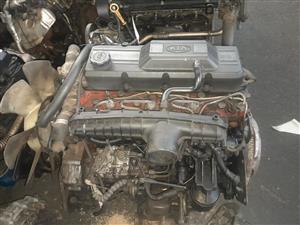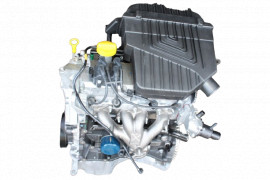Opel Corsa Engine: Efficiency and Reliability for Your Automobile
Opel Corsa Engine: Efficiency and Reliability for Your Automobile
Blog Article
In-Depth Examination of the Mechanical Parts of a Hatchback's Electric motor
Comprehending the complex operations of a hatchback's motor is akin to unwinding an intricate puzzle where every item plays an important role in the overall efficiency of the automobile. opel corsa engine. From the synchronized activities of cylinders and pistons to the precise timing of camshafts and crankshafts, each element operates in consistency to power the car. What genuinely sets a motor apart lies in the better details - the fragile dance of shutoffs and timing belts, the exact distribution of gas through injectors, and the trigger that ignites it all with trigger plugs. As we dive right into the internal functions of these mechanical marvels, a deeper recognition for the symphony of components that drive a hatchback onward arises.
Pistons and Cylinders

The efficiency and efficiency of a hatchback's engine count greatly on the smooth operation of the pistons and cylinders. Routine upkeep and tracking of these components are necessary to make certain optimal engine efficiency and durability.
Camshafts and Crankshafts
Camshafts and crankshafts play essential roles in the operation of a hatchback's interior combustion engine, helping with accurate timing and conversion of linear movement into rotational energy. The camshaft, situated within the engine block, controls the opening and closing of the engine shutoffs at certain intervals. As the camshaft revolves, its wattles push against the valves, allowing air and fuel into the burning chamber and expelling exhaust gases. This procedure synchronizes with the activity of the pistons to guarantee optimum engine performance.
On the various other hand, the crankshaft, attached to the pistons by means of attaching rods, converts the straight activity of the pistons right into rotational movement. This rotational power is after that moved to the transmission and eventually to the wheels, driving the lorry forward. The specific control in between the camshaft and crankshaft is necessary for the engine to operate effectively and create power effectively. Any kind of misalignment or malfunction in these components can cause engine efficiency issues and prospective damages. Normal maintenance and timely substitutes are needed to ensure the smooth procedure of these vital engine parts in a hatchback.
Shutoffs and Timing Belts
Playing a critical role in the synchronization and operation of a hatchback's inner combustion engine, the shutoffs and the original source timing belts work in conjunction with the crankshafts and camshafts to make certain ideal performance. Proper timing is important for the engine to work efficiently and prevent damage due to disturbance in between moving parts.

Fuel Injectors and Trigger Plugs
Fuel injectors and trigger plugs are crucial elements in a hatchback's engine system, liable for the reliable delivery of gas and ignition of the air-fuel blend. Gas injectors play a crucial role in the burning procedure by specifically splashing gas into the combustion chamber at the appropriate moment and in the appropriate amount. This controlled shipment makes sure optimum gas effectiveness and power outcome. Modern hatchbacks often make use of electronic fuel injection systems that can change fuel distribution based upon numerous aspects such as engine rate, temperature, and lots.
Along with fuel injectors, ignition system are crucial for stiring up the air-fuel blend within the engine cylinders. When the ignition system produces a high-voltage electric current, it develops a stimulate that fires up the compressed air-fuel mixture, starting the combustion procedure. Appropriately operating ignition system are essential for engine performance, gas performance, and emissions manage. Normal evaluation and upkeep of both gas injectors and ignition system are vital to make sure the engine runs smoothly and effectively.
Cooling System and Lubrication
Offered the essential function of keeping optimum engine performance and efficiency in a hatchback, the air conditioning system and lubrication systems are important parts that ensure correct working and longevity of the vehicle. The cooling system in a hatchback is liable for controling the engine temperature level to avoid overheating. It usually consists of home a radiator, water pump, thermostat, and cooling down follower, working with each other to dissipate heat created throughout engine procedure. Proper lubrication is equally important as it reduces rubbing between relocating parts, stopping damage. The lubrication system in a hatchback includes the oil pump, oil filter, and numerous lubricants that minimize friction within the engine. Routine maintenance of the cooling system includes examining coolant degrees, evaluating for leakages, and guaranteeing correct functioning of cooling down parts. In a similar way, regular oil adjustments and using the suggested lubricating substances are necessary for the lubrication system's effectiveness. Together, the cooling system and lubrication devices play a vital role in keeping the hatchback's engine running smoothly and efficiently.
Verdict

Pistons and cylinders are integral components within the interior combustion engine of a hatchback, responsible for transforming gas into mechanical energy. The camshaft, situated within the engine block, regulates the opening and closing of the engine valves at details periods.Playing an important role in the synchronization and operation of a hatchback's inner burning engine, the valves and timing belts work in conjunction with the crankshafts and camshafts to make certain optimum efficiency.Gas injectors and stimulate plugs are essential components in a hatchback's engine system, responsible for the reliable delivery of gas and ignition of the air-fuel mix. Modern hatchbacks usually utilize electronic gas injection systems that can readjust fuel shipment based on various aspects such as engine tons, temperature, and speed.
Report this page